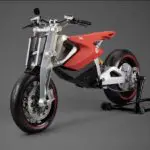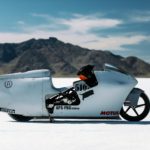Tire pressure is easy to overlook when going for a quick ride. However having the correct tire pressure for your motorcycle doesn’t just affect safety, but it also affects ride quality too.

Motorcycle tires are made of rubber. The rubber flexes under load from the motorcycle’s weight. How much the tire flexes depends on the air pressure of the tires and the weight of your bike. The tire tread in contact with the road is referred to as the “footprint”.
Tire Footprint
The size of your tire’s footprint is easily calculated. Assuming you have a motorcycle weighing 700lbs, with the rider, 35 psi tire pressure, and a 50/50 weight distribution between the tires, then the footprint of each tire is equal to 350lbs/35psi = 10 in^2. Pressure, force and area are all related. Pressure is equal to force divided by area. In this case, your force is 350 lbs per tire, and the pressure acting in the opposite direction is 35psi. The footprint or area is then equal to the force divided by the pressure. In other words if your bike weighs 700lbs and your tires have 35 psi, you’ll have a footprint of 10in^2.
If you increase tire pressure, you are reducing footprint size, but if you decrease tire pressure you increase the footprint. Your footprint size is critical to ride quality, stopping distance, traction, and even tire wear.
Tire Pressure
The tire pressure directly affects the footprint. Too small of a footprint, and your bike might not have enough traction for acceleration, cornering, or even be dangerous going over bumps. However too large of a contact patch will cause sluggish handling and even damage to the tires from over-flexing.
Tire pressure is also affected by temperature. As you’re riding, your tire heats up due to friction. The heat raises the air pressure. Also the ambient outside temp will have an affect too. Tire pressure increases 1 psi for ever 10 degree raise in air temperature. Between late fall and peak summer your tired could easily have a 5-6 psi difference.
Because heat greatly affects tire pressure it is incredibly important that you only check the tires pressure while cold. Checking pressure after riding will provide an inaccurately high reading. Tires generally need around 3 hours to cool down after riding.
Another factor you need to take in account is how much weight your motorcycle is carrying. Adding weight from gear or a passenger will require an adjustment in rear tire pressure. Refer to your owners guide for how much you should increase the rear tire pressure (usually it’s only 3-5 psi).

How Often Should you Check Tire Pressure?
You should check your tires’ pressure regularly, and before any major ride. The pressure should be checked every week. If you don’t ride frequently, it should at least be checked before every ride. The pressure should be within 1 psi of the manufacturers recommendation.
Checking regularly is always better than not at all. Underinflated tires can be dangerous to ride on. On the other hand overinflated tires will reduce contact patch and reduce handling, but they will wear slower due to less rubber hitting the road.
Conclusion
Tire pressure is critical to happy and safe motorcycling. There are best practices you should follow regarding your tires.
- Always check tires when they are called
- Check tire pressure weekly or at least before every long ride
- Always follow manufacturer’s guidelines for tire pressure
- Tire pressure should be adjusted depending on motorcycle load
- Use a quality gauge when checking tire pressure



